2013 Arctic Sea Ice Extent Prediction
Posted on 20 February 2013 by dana1981, Dikran Marsupial
We previously examined various predictions of the annual Arctic sea ice extent September minimum from 2008 through 2012, using a variety of methodologies (statistical, modeling, and/or "other"). Overall the statistical- and model-based predictions have been equally accurate, with an average difference from the observational data of 13%. Skeptical Science's Gavin Cawley (Dikran Marsupial) has been better than average with his purely statistical predictions, averaging a 10.6% difference from the annual minimum. Cawley describes his methodology thusly:
"I obtained from data for Arctic sea ice extent from 1979-2009 [2012 for the most recent predction]...I then fitted a Gaussian process model, using the excellent MATLAB Gaussian Processes for Machine Learning toolbox (the book is jolly good as well). I experimented with some basic covariance functions, and chose the squared exponential, as that gave the lowest negative log marginal likelihood (NLML). The hyper-parameters were tuned by minimising the NLML in the usual way."
2013 Predictions
Cawley's results are shown in Figure 1, and predict a 2013 September Arctic sea ice extent of 4.1 ± 1.1 million square kilometers.
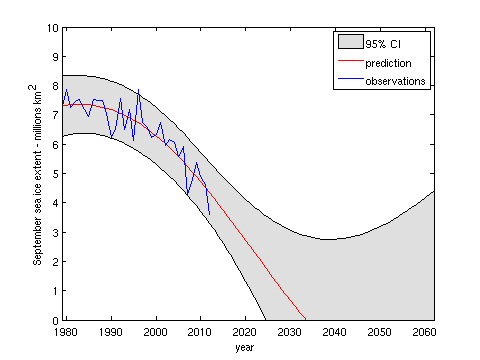
Figure 1: Gavin Cawley's Gaussian Process statistical Arctic sea ice extent prediction
It is important to note that this is a purely statistical approach, and hence some of the longer-range aspects of the prediction seem implausible, given our knowledge of the physics of Arctic sea ice. Firstly, the model predicts that the Arctic will be ice-free in September from about 2034, however in reality this is likely to be a rather pessimistic prediction. As Walt Meier explains,
"... the rapid losses have come from the Siberian and Alaskan regions of the Arctic. The region along northern Greenland and Canadian Archipelago have not lost much summer ice – for good reason. The predominant ice circulation pushes ice toward those coasts resulting in thick ice that tends to get replenished. In other words, we’ve seen a rapid decline in the “easy” ice to lose, but now we’re getting to the “more difficult” ice. I think it’s likely that that will go more slowly."
Secondly, the upper boundary of the credible interval suggests that it is plausible that sea ice may begin to increase again after 2040. There is no physical reason why this should be the case. Essentially the only expert knowledge built into the model is that the underlying long-term variation of Arctic sea ice extent is expected to be a smooth function of time (encoded by the use of the squared exponential covariance function - the degree of smoothness is inferred from the data), and the broadening of the credible interval as the model extrapolates away from the observations is in reality merely an indication that the model has no real confidence in its predictions beyond a handful of years in the future. Beyond 2030 or so, the model has little or no predictive skill; however, one of the nice things about this approach is that the user is alerted to this issue that by the breadth of the error bars.
Tamino at the Open Mind blog has likewise made statistically-based predictions, and has also been more successful than most, averaging an 8.6% difference from the annual minimum. Tamino has also offered his 2013 prediction, of a 3.97 ± 0.9 million square kilometer Arctic sea ice extent.
Figure 2: Tamino's Arctic sea ice fits with a quadratic function (model 1; blue) and a modified lowess smooth (model 2; red).
Note that neither Cawley nor Tamino predicts that 2013 will break the 2012 record (3.6 million square kilometers). There is a principle in statistics known as "regression toward the mean," which is the phenomenon that if an extreme value of a variable is observed, the next measurement will generally be less extreme, i.e. we should not expect to observe record lows in consecutive years. This is because when extremes are reached and records are broken, a number of different variables generally have to align in the same direction to make this happen. That being said, a new record in 2013 is well within the range of uncertainty in both Cawley's and Tamino's statistical predictions.
The Predicted "Record Recovery"
Anthony Watts and Steven Goddard, who have combined to make the most inaccurate Arctic sea ice predictions (Figure 3), have recently managed to make an argument that is both astonishing and entirely predictable.
Figure 3: Percent difference between predictions and actual annual Arctic sea ice minima for individuals and groups which have made a minimum of two predictions in SEARCH and elsewhere.
Watts and Goddard are now claiming that "the Arctic has blown away the previous record for ice gain this winter." However, Cawley shows that this is an entirely predictable result, quite simply because the annual sea ice minimum extent is decreasing faster than the annual maximum. With the distance between the minimum and maximum thus increasing, a larger "recovery" over the winter is exactly what we expect to see (Figures 4 and 5), and does not suggest any recovery in Arctic winter sea ice. This is clearly seen by presenting the ice gain as the difference between September and January observations, as shown in Figure 4(b), rather than as a simple bar chart without this context, as shown in Figure 4(a).
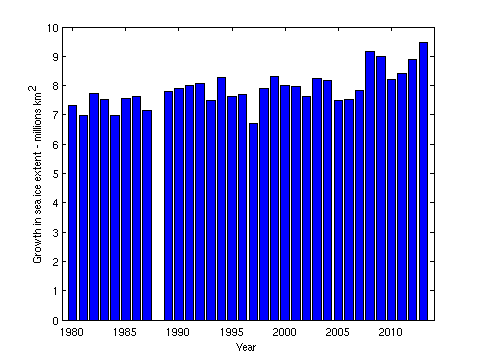 |
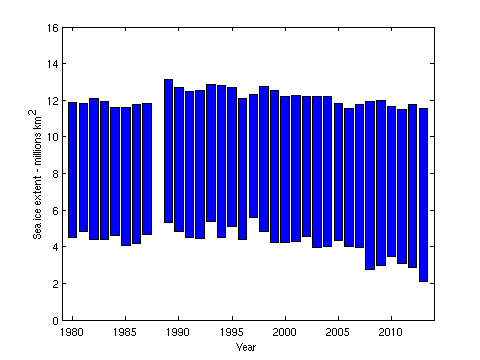 |
| (a) | (b) |
Figure 4: Difference between annual January and September Arctic sea ice areas. The size of the blue bars represents the size of the sea ice "recovery" each year (n.b. there is a known discontinuity in the area measurements ocurring in 1987, clearly visible in the observations, of around 0.88 million km2, due to an increase in the region imaged by the sensors on the satelites.).
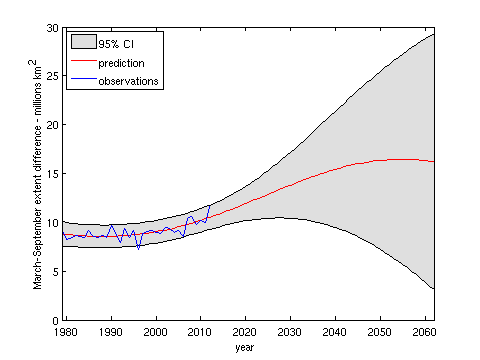
Figure 5: Predicted March-September Arctic sea ice extent difference, or "recovery", using Gavin Cawley's statistical approach.
As these figures show, the annual "recovery" has generally grown over time, and is predicted to continue to grow, simply because the annual sea ice minimum is falling faster than the annual maximum.
Sea Ice Volume
It's also always important to remember that ice is three-dimensional, and so looking at Arctic sea ice extent misses the rapid decline in the thickness of the ice as well.
To illustrate that point, Andy Lee Robinson has put together several great graphics based on the Pan-Arctic Ice Ocean Modeling and Assimilation System (PIOMAS) data from the University of Washington’s Polar Science Center. Now the European Space Agency’s CryoSat-2 probe has generally confirmed the PIOMAS results.
Robinson's two most recent graphics illustrate the incredible loss of Arctic sea ice volume between 1979 and 2012, representing them as ice cubes on a 10 kilometer grid map of New York, and in spiral form, illustrating that the sea ice volume has dramatically declined in every calendar month since 1979.
Robinson is also the creator of this graphic and video illustrating the Arctic sea ice mass loss.
Summary
To sum up,
- statistically-based Arctic sea ice minimum extent predictions have performed relatively well, and expect a continued rapid long-term decline.
- however, they predict that we will most likely not see a new record minimum Arctic sea ice extent in 2013.
- overly optimistic contrarian sea ice predictions have had the worst results; now they're celebrating the "record sea ice recovery", which is an expected result because the minimum extent is declining faster than the maximum extent.
- Arctic sea ice volume is also declining at an alarming rate - we've lost approximately 80% of the total volume over the past three decades.































 Arguments
Arguments





















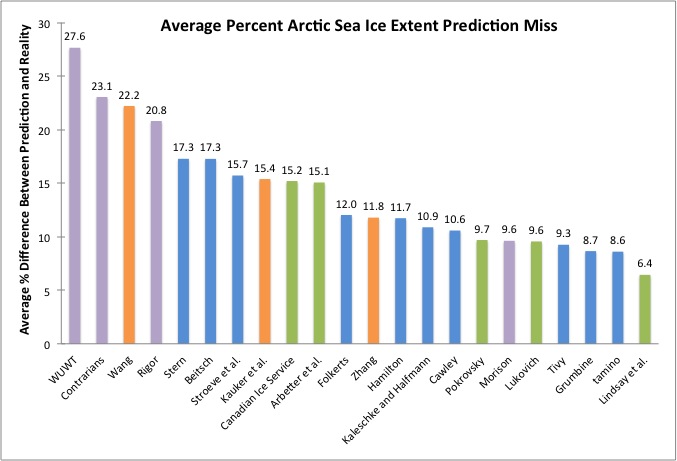
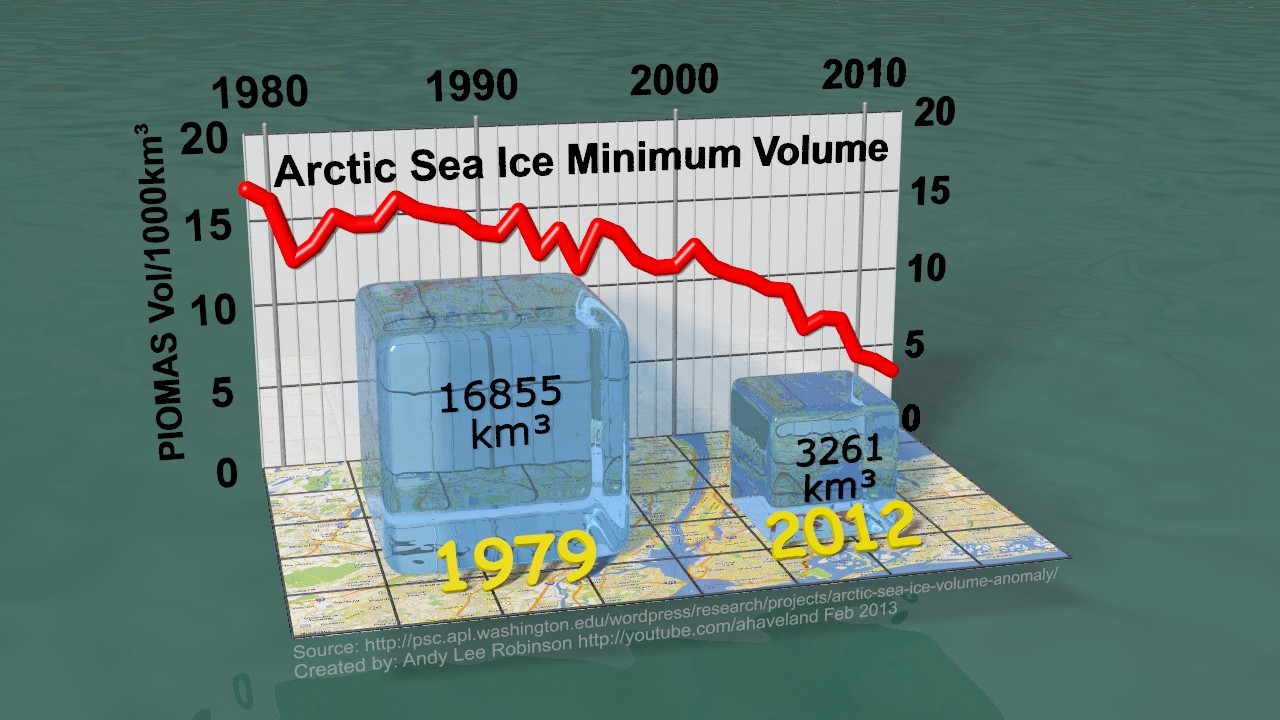
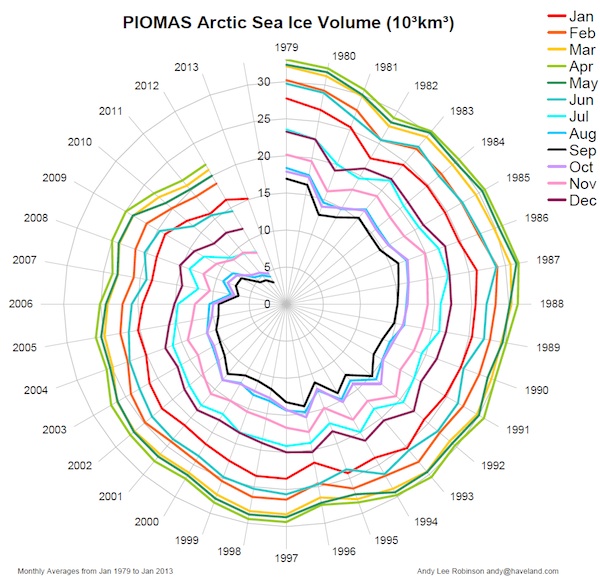









Note that the summer storm had a small impact on the 2012 Arctic sea ice minimum. There almost certainly would have been a record even without the storm.
Keith #43 - my observations and expectations match yours.
I have a small pond outside my living room window that freezes to 100% extent and melts to 0% multiple times per year. After being frozen over for days, it goes from almost frozen over to ice free in short hours.
The Arctic sea ice has gotten (comparatively) very thin. A few decades back the Russans set up their ice observatory stations on 20'/6m thick ice. Now they report that they have to hunt for 6'/2 meter ice. And they have to be prepared to move quickly if that ice begins to break apart.
I think that in the next few years we'll see a rapid melting of first year ice and that will clear the Fram and CA channels for the last remaining multi-year ice to be flushed out of the Arctic. I won't be surprised to go from significant extent to "Where's the ice?" in less than a month.
My "prediction" is 4.2million Km2, based on cheating, i.e. putting a straight-edge up to the computer screen, and eyeballing a vertical line through Gavin Crawleys prediction line in Fig. . The intersection for 2013 minimum is ~4.2 million Km2 (with a low of ~3.2 and a high of ~5.1 million Km2)
Given that Gavin's predictions have proven better than average, and also that there is an ongoing trend of less multi-year ice (oops, sorry Steve Goddard, I mean an ongoing trend of "increasing extent of Jan-Sept. ice growth") it doesn't make any sense to choose something like 5million Km2 as a likely ice extent, and then put an error bar on that.
Kevin, it was Phillipe's question that you ducked, so your reply should have been directed to him. I was merely pointing out to you that if you want to take part in a scientific discussion, giving adequate answers to peoples questions and not avoiding difficult issues is generally a good idea.
These predictions assuming constant thickness ignoring actual oberservations do not even work as first approximation. Wasn't the final advice from last SEARCH sea ice outlook to include volume?
Sea ice went from a mostly perennenial to a predominantly seasonal ice pack. Cryosat and PIOMAS both agree on meters of tickness lost North of Greenland and the Archipelago. Ice drift speed doubled in recent decades probably rendering Meier's point meaningless. Absorbing new observations the discourse moved on long ago.
Don't irresponsibly feed policymaker with a prediction of an ice free Arctic in decades based on extent math while all other facts propose that will happen in a few hundred weeks.
Get sceptic on the skills of a sea ice model ignoring thickness and dynamics.
artcicio - the predictions do not assume constant thickness. They do not take advantage of our knowledge of thickness, but that is not the same thing. I suspect that one of the reasons for looking at extent, rather than volume is that there is insufficient historical data available, which meant that until recently, models of ice volume were too uncertain.
Note Walt Meiers comments about the timing of an ice-free Arctic, they apply to volume just as they do to extent/area.
If we look at the extent (length x width / concentration) trend the ice will be gone in ~20 years.
If we look at the area (length x width) trend the ice will be gone in ~10 years.
If we look at the volume (length x width x thickness) trend the ice will be gone in ~5 years.
Notice how the duration shrinks as the 'completeness' of the information increases. That is, ice volume tells us about ALL of the ice while area ignores thickness and extent is area further distorted by how concentrated the ice is. All three of these trends have been accelerating AND converging. The gaps between them were much greater even just five years ago. In another five years I think they'll be in near alignment... either because they will have all hit near zero or because the extent and volume will converge on the area trend. I don't think there is any chance of the extent trend being the 'correct' one.
All right Kevin, if I read you correctly you're saying that the 2012 happened because it's been really warm in the Arctic for years and that whenever there is small "recovery" of the se ice, it is drowned in the staggering loes of the not so food years. Makes sense.
Kevin it is so unfair when all this heat comes from nowhere! Did someone leave the fridge door open?
The Arctic Ice melting at unprecedented rates is a symptom. Not a cause. It can only be due to excess heat accumulating on Earth. I wonder what the mechanism could be. Could it be the lack of Unicorns or pirates?
Some say it is due to 'natural' forces. All very glib until there is no real mechanism behind what is observed.
There is a well known cause and it is the increase in the greenhouse gas called CO2.
We even have people saying that a 'simple' animation can be done in a few minutes by some script kiddie.
Apart from the realistic three dimensional look of the animation. The POV lighting with moving shadows make it look far more natural.
I reckon Leonardo Da Vinci knocked up the Mona Lisa in one afternoon. It took far longer to paint her.
Bert
What fun. Assuming we are talking about Sept 15 and not Sept as a whole and with no mathematical justification at all, I predict that the ice extent will be a little lower this Sept 15 than in 2012. In 2014 or 2015 it will shoot down again and may well reach close to zero by 2016. Note that as a first approximation, ice volume should be: extent raised to the 3/2 power. That is, if there is 80% as much ice area this year compared to last year, the ice volume should be 0.803/2 = 0.72. This assumes that thickness decreases at the same rate as length and width. By the by, with no ice cover to insulate the ocean we would expect more ice to form during the winter and this is what is happening. In so far as the brine produced is sinking and sucking more surface water northward we would expect the ice cover around and north of Svalbard to decrease each winter and that is what is happening.
First posting on this website. Greetings to all.
My estimate for 2013 minimum ice volume is 2221 km^3 based on the steepening trend seen in the last 6 years of the PIOMAS graph. If assymetric error margins are permitted, I will say +2500/-500 km^3 based on 2500 being roughly the amount of lumpiness in that section of the graph and -500 on an unsubstantiated hunch about the most northerly part of the ice sheet being the hardest to melt.
Based on the earlier mention that research crews are now having to 'hunt' for ice thickness of 2m and taking that as a crude average thickness, my prediction for ice extent works out to 1,110,600 km^2, or a radius of ~595 km, if it were perfectly centered on the pole (c.f. ~700km from north coast of Greenland to the pole).
I found out more than I needed to know about Steve Goddard when he infested a Washington Post Op-Ed called Climate science tells us the alarm bells are ringing by posting 500 comments out of less then 5000 this weekend. Truth be told, I lost count of his comments last night at about 200 but he has been hard at it all day today. Sadly, the Washington Post blogs has very loose moderation standards, so anyone can get away this this stuff. It just makes it impossble to have a real discussion about climate change, but I suppose that is Goddard's goal. They just don't want others talking about climate change.
Let's summarise:
Kevin - 5,000,000
dwr - 4,250,000
Roger D - 4,200,000
scaddenp - 4,100,000
KR - 4,040,000
DSL - 3,900,000
Michael sweet & Paul W - 3,000,000
L Hamilton - 2,300,000
Eternal Consumption - 1,110,00
Did I miss anyone? Quite a range. Anyone care to change their quess?
Nope. You're sniping from the audience. Why didn't you step in the ring? You're not going to make it worse by pulling a Goddard and claiming long-term recovery based on one year, are you?
Want to predict GISS L-OTI anomaly for July?
I remember saying earlier this year that I thought this year would actually break last year's minimum. I'm probably going to be wrong on that point, but there are still about 6 weeks of rapid melt left.
And I noticed just today there is a shift in direction in the NSDIC chart... toward more rapid melt.
I should probably be on that list with Paul and Michael at 3m sq km.
It's not really fair for me to guess now when it looks like most of these guesses were made months ago.
As to the Goddard ref.... 1 year data point does not a trend make.
I know it is still early in September, but it looks like we have a winner with Kevin @ 5,000,000 km2.
The only question left, is will the final tally fall within his +/- range of 100,000 km2.
I'm posting this here because the 'Arctic ice loss is natural' thread has benne dead since 2010 (a problem that wouldn't exist if the website had an email notification option!):
I'm debating a Watt-bot and he's claiming that Arctic ice decline is all due to changes in wind patterns. He's posted several articles, but the broadest claims are made here:
Wind contributing to Arctic ice loss, study finds
Anything in the article that points out this doesn't question climate change's role he describes as spin - even though the study itself only seems to attribute 30-50% of the ice loss to changing wind patterns, according to the article.
Apparently this line is the dominant response to Arctic ice loss at WUWT other than the occasional rallying cry of "Recovery" (such as we are currently hearing). Any thoughts on this?
[DB] Again, NO THREADS ARE DEAD at SkS. Regular participants follow the Recent Comments thread, so that no matter where ANY comment is made, it will be seen. And then responded to.
Please repost this on this thread, where others will then appropriately respond to you:
Arctic icemelt is a natural cycle
This comment will be deleted in a little bit. Parties interested in responding to Dvaytw, please do so at the link.
While the max extent in the spring is not as important as the min, it would still be interesting to see people's predictions for that. Is SkS going to do something like that? Is there any chance of Mr. Robinson updating his spiral graph?
When are 2014 predictions going to happen?